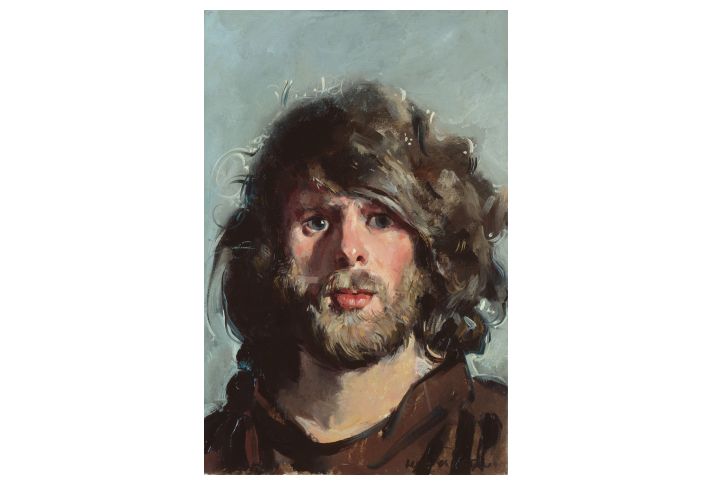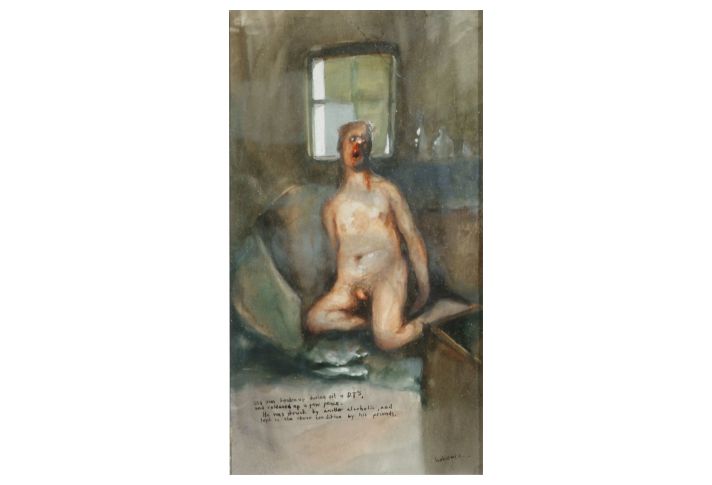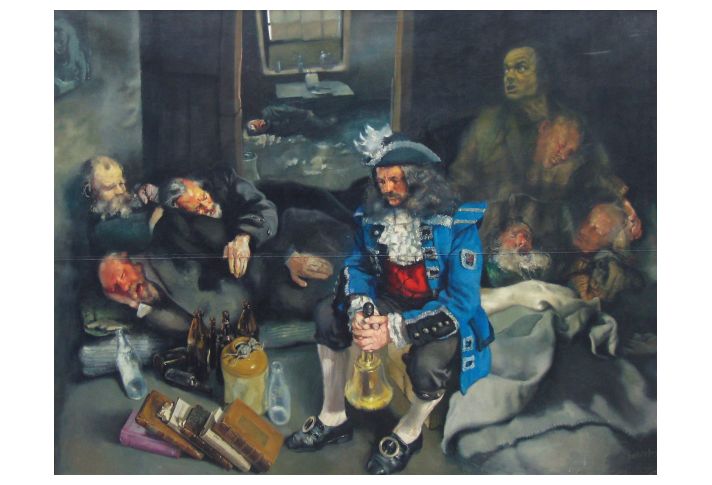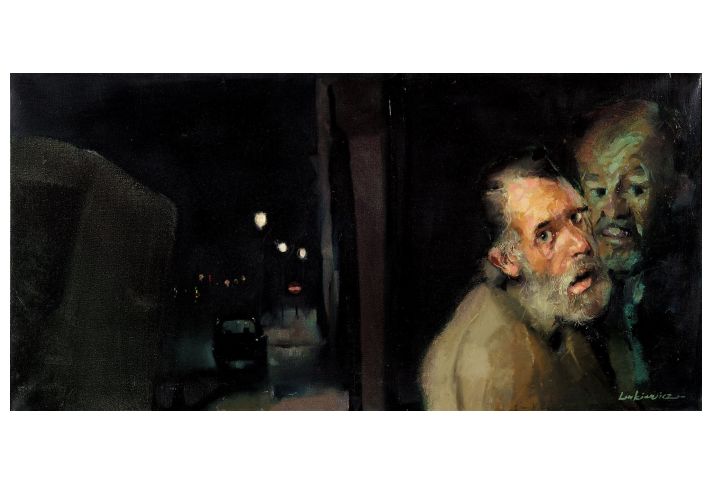R.O. LENKIEWICZ PAINTINGS
May 6 to June 20 1975 Blenheim Gallery 21 Cork Street W1
NOTE Amusing or not, the present exhibition is a joke. It is hoped that those who profess an interest will take the trouble to read the leaflets that accompany the collection.
1. The Red Chair* £500 * This has been submitted to the Royal Academy.
2. Painter and female associate NFS
3. Painter and female associate £100
4. Painter and female associate £110
5. Painter and female associate £100
6. Painter and female associate £120
6a. Painter and female associate £90
6b. Painter and female associate £100
6c. Painter and female associate £90
7. The Painter aged 92 £100 Completed shortly before he died
8. The Painter with Courbet’s Self-portrait £140
8a. The Painter with Van Gogh’s Self-portrait £140
8b. The Painter with Rembrandt’s Self-portrait £140
9. The Painter aged 32 £100
10. The Painter aged 32 £110
11. The Painter aged 17 NFS Painted at the age of 17
12. The Painter aged 16 NFS Five studies painted at the age of 16
13. The Painter aged 32 £90
14. The Painter aged 32 £85
15. The Painter aged 32 £115
16. The Painter at 32 £115
Miscellaneous
17. a. Roger and Roger standing on the Barbican at 12 noon
b. Barbican Boys
c. Two vagabonds of Spain £115
18. Roger with cap £65
19. Roger with cap £60
20. The Painter’s right boot £110
21. Part of the Painter’s antiquarian erotica collection £110
22. Apple and Grapefruit £85 It may be of special interest to note that the painter ate both these items on completion of the study
23. Tomato and Onion £50
24. Banana £50
25. 26 of the Painter’s signatures (On an old palette) £60
THE DIOGENES CON SHOW
Effective posters of this man’s head are available from the desk: price £2
26. This study took 39 minutes £90
27. This study took 41 minutes £90
28. This study took 37 minutes £90
29. This study took 27 minutes £90
30. This study took 30 minutes £90
31. This study took 39 minutes £90
32. This study took 1 hour 18 minutes £100
33. This study took 34 minutes £75
34. This study took 23 minutes £55
35. This study took 35 minutes £75
36. This study took 41 minutes £90
37. This study took 43 minutes £90
38. This study took 27 minutes £60
39. This study took 17 minutes £60
40. This study took 22 minutes £60
41. This study took 27 minutes £60
42. This study took 29 minutes £60
43. This study took 37 minutes £100
44. This study took 1 hour 11 minutes £75
45. This study took 8 minutes £40 (Diogenes’ hand clutching American tourist’s 50 pence piece)
46. This study took 14 minutes £45 (Diogenes’ hand holding Painter’s pound note)
47. This study took 11 minutes £35
48. This study took 9 minutes £35
49. This study took 14 minutes £35
50. This study took 12 minutes £35
51. This study took 10 minutes £35
52. These studies took 38 minutes right-hand head, 44 minutes left-hand head £130
53. This study took 49 minutes £95
54. This study took 54 minutes £80
55. This study took 43 minutes £100
56. This study took 38 minutes (Monochrome Gouache) £65
57. This study took 34 minutes £90
58. This study took 25 minutes £45
59. This study took 7 minutes £20
60. The putrefaction of Diogenes Not for sale
THE MASTERPIECE MUSEUM
The gallery has experimented with a small display of the work of a now forgotten painter. Please take leaflet to the left of the entrance.
61. Old man beaten up during fit of the D.T.’s £75
62. Eddie Fagin; Notes £45
63. Study of Albert in front of a study of Albert £135
64. Study of Albert £30
65. Albert falling asleep £120
66. View of the Barbican with human interpolation £100
67. Cyril £80
68. Cyril (Two studies) £90
69. Cyril £35
70. Cyril £45
71. Harry asleep (Two studies) £90
72. Diogenes asleep £35
73. Albert asleep; five studies £85
74. Albert asleep £85
75. Albert with clown doll £90
76. The Masterpiece; or, ‘Plymouth mourning over its unfortunates’ Value? Priceless
This complex work conceals a large amount of allegorical symbol; suffice it to say that what is known of it’s underlying meaning covers the following associations: THE SEVEN SLEEPERS OF EPHESUS: THE STUDIO, BY GUSTAVE COURBET: SOCIAL ART AT IT’S WORST: THE MYTHOLOGY OF SLEEP, etc.
77. Dave Hocking asleep £90
78. Mac £100
79. Mac £110
80. Barbican night scene with human interpolations £130
81. Study for redundant ‘Masterpiece’ pilgrim £95
82. Cowboy’s Holiday Inn; study £40
83. Study of Diogenes’ piss-pot and dishevelled beds £45
84. Tinker Jo £40
85. Harry and Diogenes asleep £50
86. Les Ryder £50
87. The Singer £65
88. The Singer and Diogenes £100
89. Studies of Albert £90
90. Dave Hocking. Studies £50
91. Studies of Albert asleep £75
92. Diogenes at the Barbican Fair £75
Some attention should be drawn towards the manuscript cabinet which contains a few very rare examples of the painter’s numberless sketch-books.
We are grateful to the Plymouth Archives for the loan of these items. The remainder were unfortunately stolen from the museum by an irresponsible art student some years ago. An added attraction is the collection of miscellaneous pieces in the tall cabinet near the entrance. Of special interest is the article on ‘The Uses of Bad Art’ by Geoffrey Grigson. It is said that the painter died with this paper clutched to his heart.
There are no ‘last words’ recorded of this strange man: though it is significant that an envelope filled with cuttings and quotations of famous last words, was after found beneath his pillow. In the cabinet can be seen a feeble scrawl on blue paper (one of many in the envelope) which says:
‘I have as my guarantee the hatred
I bear towards men and towards our
society, which will last as long as I live.’
Courbet to Bruyas, 1854
This blue scrap was underlined and on the floor; it would not be over-imaginative to speculate that this indeed was the intended ‘last word’ of our hero.
SOME BRIEF BIOGRAPHICAL DETAILS
Robert Lenkiewicz - Born 1942 - Attended Saint Martin’s School of Art in London and the Royal Academy. His Grandfather had been Court Painter to Ludwig of Bavaria, and although Lenkiewicz shrugs off this distinguished ancestor as an average painter, he presumably inherited something of his skill. Lenkiewicz is responsible for painting the now famous Barbican Mural in Plymouth. This massive work covers 3,000 sq. ft. and is in the Elizabethan period, with complex reference to alchemy, Mysticism and Metaphysical thought.













